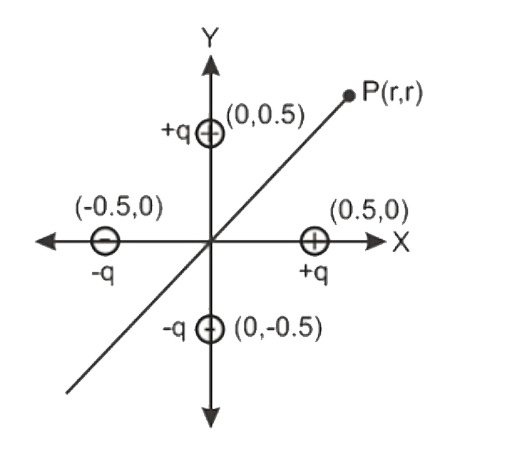Three equal and similar charges are placed at and . What is the nature of equilibrium of the charge at the origin-
Stable when moved along the Y-axis
Stable when moved along Z-axis
Stable when moved along X-axis
Unstable in all of the above cases
The correct Answer is:C
Step by step video, text & image solution for Three equal and similar charges are placed at (–a, 0, 0), (0, 0, 0) and (+a, 0, 0). What is the nature of equilibrium of the charge at the origin- by Physics experts to help you in doubts & scoring excellent marks in Class 12 exams.
Updated on:21/07/2023Topper's Solved these Questions
Similar Questions
Four equal point charges Q each are placed in the xy plane at (0,2), (4,2), (4,-2) and (0, -2). The work required to put a fifth charge Q at the origin of the coordinate system will be
View SolutionFour equal point charges Q each are placed in the xy plane at (0,2), (4,2), (4,-2) and (0, -2). The work required to put a fifth charge Q at the origin of the coordinate system will be
View Solution
Knowledge Check
Four identical charges are placed at the points (1,0,0),(0,1,0),(−1,0,0), and (0,−1,0). Then,
Athe potential at the origin is zeroBthe electric field at the origin is not zero.Cthe potential at all points on the z - axis, other than the origin, is zeroDthe field at all points on the z - axis, other than the origin acts along the z - axis.Three point charge q1=1μC,q2=−2μC and q3=3μC are placed at (1m,0,0),(0,2m,0) and (0,0,3m) respectively. Find the electric potential at the origin.
A2.0×103VB9.0×103VC1.0×103VD10×103VFour charges +q,+q−q, and -q are placed on X - Y plane at the points whose coordinates are (0.5,0),(0,0.5),(−0.5,0)and(0,−0.5) respectively.

The electric field due to these charges at a point P(r,r), where r>>0.5, will beA14πε0×q2r3B14πε0×qr3C14πε0×3qr3D1πε0×qr3
There exists a uniform magnetic field →B=+B0ˆk for x>0and→B=0 for all x<0. A charged particle placed at (0,−a,0) is given an initial velocity →v=v0ˆi. What is the magnitude and nature of charge on the particle such that it crosses through the origin ?
Strategy: When the charge is projected perpendicular to a uniform magnetic field, it follows a circular path. In this case, the force acting on it will be directed either towards +y-axis. or y-axis. It is given that it crosses point O. Thus, the force at (0,−a,0) must be towards y-axis
View SolutionTwo equal charges are placed at a separtion of 1.0 m. What should be the magnitude of the charges so that the force between them equals of a 50 kg person?
View SolutionTwo charges -q and +q are located at points (0, 0, –a) and (0, 0, a), respectively.
(a) What is the electrostatic potential at the points (0, 0, z) and (x, y, 0) ? (b) Obtain the dependence of potential on the distance r of a point from the origin when r/a>>1.
(c) How much work is done in moving a small test charge from the point (5,0,0) to (–7,0,0) along the x-axis? Does the answer change if the path of the test charge between the same points is not along the x-axis?
View SolutionThe point charges q1=1μC,q2=−2μC and q3=3μC are placed at (1m,0,0),(0,2m,0) and (0,0,3m) respectively. Find the electric potential at origin.
View SolutionTwo points +ve charges q each are placed at (-a, 0) and (a,0), A third +ve charge q0 is placed at (0, y). Find the value of y for which the force at q0 is maximum.
View Solution
